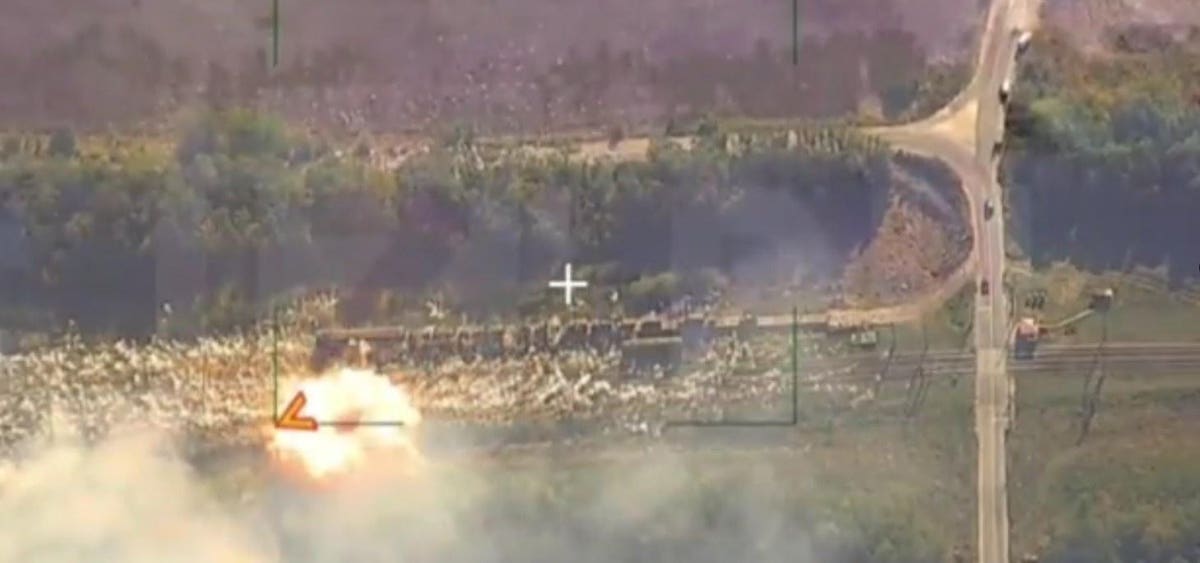A dramatic Russian strike on a Ukrainian train laden with military vehicles range like an alarm bell among close observers of Russia’s 21-month wider war on Ukraine.
Far more than most other countries, Ukraine utterly depends on its national rail operator, Ukrzaliznytsia, for transportation—including the transportation of troops and equipment.
If the Russians systematically strike the trains, they could paralyze the Ukrainian war effort. Did the strike on a train just outside Zaporizhzhia, in southern Ukraine on or before Sept. 30, signal a concerted effort by the Russians to unravel the Ukrainians’ logistics?
Actually, no. The recent strike stands out not because it represents a new counter-rail campaign, but because there’s a clear video—shot by an overhead Russian drone—of the attack.
In fact, after a brief period early in the war during which the Russians ignored Ukraine’s trains because they assumed they quickly would capture them, Moscow’s force’s deliberately have targeted the Ukrainian rail system.
Bombs, rockets, cruise missiles and drones have struck scores of trains, rail stations and depots, railway bridges and switching stations. According to Foreign Policy, around 400 of Ukrzaliznytsia’s 220,000 employees have died in Russian attacks.
For all of their trying, the Russians can’t wreck the entire Ukrainian rail network because the network is vast and durable. There are nearly 15,000 miles of track—the third most of any European country. Two thousand locomotives pull 90,000 passenger cars and freight wagons serving 1,500 stations.
That’s a lot of targets for a Russian strike complex that struggles to target critical nodes in complex networks, in particular moving nodes. It’s worth noting that the train in the recent strike was idle when a Russian missile—reportedly a four-ton Iskander—struck close to it and possibly damaged the locomotive and some of the dozen military cargo trucks on its freight wagons.
The Kremlin began targeting Ukrzaliznytsia in the spring of 2022, after the Ukrainian military defeated the Russian armored assault on Kyiv, making a mockery of the Russians’ goal of “demilitarizing” Ukraine in two weeks.
Russian and collaborationist officials periodically renew their pledge to destroy Ukrzaliznytsia, most recently in March. “The railways are crucial for the … regime’s ability to redeploy forces,” Vladimir Rogov, a collaborator in Rusisan-occupied Zaporizhzhia, told Russian state media.
But Russia’s spy satellites can’t reliably track the movement of thousands of trains, even when the trains concentrate for a mass haul of Ukrainian troops. In March 2022, trains shifted three or four brigades a day without Russian spacecraft noticing, according to the Royal United Services Institute in London.
Even if the Russians did reliably track trains and could prioritize them for attack, the Ukrainian air force has extended its new Western-made air-defenses over the most critical rail nodes.
And when a Russian strike gets lucky and gets through, Ukrzaliznytsia quickly repairs the damage. The Kyiv Electric Carriage Repair Plant is working at 140-percent capacity to fix damaged rails, bridges, locomotives and cars. “Last year, we did more trains than in any other year before,” Oleh Holovaschenko, the director of the plant, told Foreign Policy in August.
All that is to say, Ukraine’s trains are hard, hard targets. One Russian strike on a single locomotive and its cargo doesn’t mean the greater network is in any greater danger than it already was in.
Read the full article here





